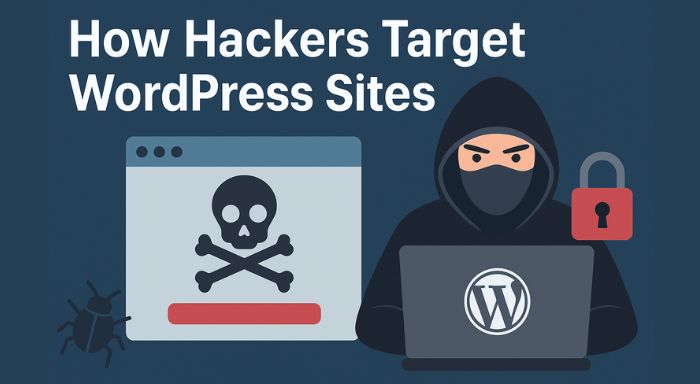WordPress also happens to be the most popular content management system (CMS) in the world with over 40 percent of all internet-based websites powered by WordPress. It is also, unfortunately, a favorite target of hackers as well due to its popularity. The hackers usually use the vulnerabilities of the plugins, themes, and outdated installations as a means of unauthorized entry. Assuming that you have a WordPress site, be it a small one or a big one, the first step towards the security of a WordPress site is to understand how hackers target WordPress sites. Web tools such as WP-1Click have simplified the process of managing and customization of websites, although security should never be ignored.
We will discuss in this paper the most popular methods that hackers are using to access your WordPress site, how to identify the fact that someone has been attacking your site, and what you can do to secure your site.
Why Hackers Target WordPress Sites
Before diving into the techniques hackers use, it’s important to understand why they do it. Not all hackers are after your personal data; many exploit WordPress websites for broader reasons:
- Financial Gain: Hackers may insert malicious ads, steal customer payment details, or spread ransomware.
- Spamming: Compromised websites are often used to send spam emails or host spammy content.
- Botnets: Hackers take control of vulnerable WordPress sites to use them in distributed denial-of-service (DDoS) attacks.
- Reputation Damage: Competitors or malicious actors may want to ruin your online credibility.
Since WordPress websites are often less protected than corporate systems, they’re a soft target for hackers.
Common Methods Hackers Use to Target WordPress Sites
Hackers are constantly coming up with new techniques, but some attack methods remain the most common. Let’s look at them in detail.
1. Brute Force Attacks
Brute force attacks involve hackers using automated bots to guess login credentials. They try thousands of username and password combinations until they get in. Weak passwords such as “admin123” or “password” make this process much easier.
2. Vulnerable Plugins and Themes
Plugins and themes expand WordPress functionality but can also open the door to hackers if they’re not updated. Outdated or poorly coded themes may allow hackers to inject malicious scripts into your site.
If you use a WordPress Theme Builder to customize your design, make sure it comes from a trusted source and is regularly updated.
3. SQL Injections
SQL injections exploit vulnerabilities in your site’s database queries. With this technique, hackers can gain access to your WordPress database, allowing them to steal sensitive data, create new admin accounts, or even delete entire tables.
4. Cross-Site Scripting (XSS)
In XSS attacks, hackers inject malicious scripts into your site’s content. Visitors who load the infected page unknowingly execute these scripts, which may redirect them to phishing websites or steal their cookies and session data.
5. Malware Infections
Hackers often inject malware into WordPress sites through outdated plugins or unauthorized uploads. Malware can:
- Redirect visitors to harmful sites
- Insert spammy links
- Track keystrokes
- Spread to other connected systems
6. File Inclusion Exploits
WordPress relies on PHP files for functionality. Hackers may exploit insecure file inclusion settings to access sensitive files like wp-config.php, which contains critical database information.
Signs Your WordPress Site Might Be Hacked
It’s not always obvious when your site has been hacked. However, here are some warning signs:
- Sudden drop in website performance or speed
- Unexpected redirects to unknown websites
- Unknown admin accounts appearing in WordPress
- Spammy links or content posted on your site
- Search engines flagging your website as unsafe
Catching these early can minimize damage.
How Hackers Exploit Weak Security
The table below highlights the weaknesses hackers target and their corresponding risks:
| Weakness | How Hackers Exploit It | Risk to Your Site |
| Weak Passwords | Brute force attacks using bots | Unauthorized admin access |
| Outdated Plugins/Themes | Use vulnerabilities in old versions | Malware injection, data theft |
| Poor Hosting Security | Target hosting servers with weak firewalls | Full server compromise |
| Lack of SSL Certificate | Intercept unencrypted data | Stolen login credentials or payment details |
| No Regular Updates | Exploit unpatched WordPress installations | Complete website takeover |
| Misconfigured File Access | Exploit insecure file permissions | Access to sensitive files |
Best Practices to Protect Your WordPress Site
Now that you know how hackers target WordPress sites, let’s look at the preventive measures:
1. Use Strong Passwords and Two-Factor Authentication
Avoid common or simple passwords. Use a mix of uppercase, lowercase, numbers, and symbols. Adding two-factor authentication (2FA) provides an additional layer of security.
2. Keep WordPress, Plugins, and Themes Updated
Outdated software is the number one entry point for hackers. Always install updates as soon as they are available.
3. Choose Secure Hosting
Pick a hosting provider that offers firewalls, malware scanning, and regular backups. Cheap hosting may save money upfront but increases long-term risks.
4. Regular Backups
Maintain daily or weekly backups of your site. This ensures you can restore your website quickly if it’s hacked.
5. Install Security Plugins
Plugins like Wordfence or Sucuri help detect suspicious activity, block brute-force attacks, and scan for malware.
6. Limit Login Attempts
Restrict the number of login attempts to prevent brute force attacks.
7. Secure File Permissions
Ensure sensitive files like wp-config.php and .htaccess have correct permissions.
The Role of Awareness and Monitoring
Negligence is the favorite of hackers. Most of the owners of websites believe that their site is too small to be a target, yet their site is valuable to hackers. Frequent checks, knowledge about the current threats, and simple security hygiene would go a long way in ensuring that your WordPress site is secure.
Conclusion
The security of WordPress websites is attacked by hackers in many ways such as brute force, weak plugins, SQL injections, and malware. Nonetheless, in place of the threat of an attack, you can significantly reduce it with the help of good passwords, safe hosting, regular updates, and good backups.
It is important to remember that security is a process and not a one-time activity. No matter what you are operating, be it a personal blog, an online store or a company site, security is what matters the most due to the fact that it is not only guarding your information but also your reputation.
If you are just starting your journey to securing your WordPress site, check out our detailed guide on Website Security for Beginners.


Leave a Reply